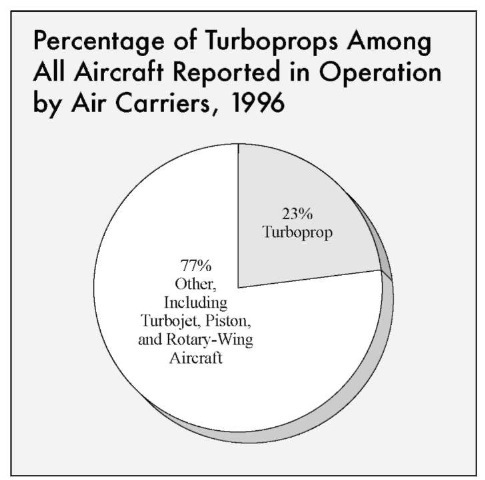Also known as: Propjets,jetprops
Definition: A variation of the gas turbine engine that develops thrust with propellers instead of the exhaust duct.
Significance: The turboprop is a very popular aviation engine designed to be fuel-efficient and to propel airplanes at moderately high speeds and altitudes.
History
The idea for using a gas turbine engine to drive an airplane’s propeller was first thought of by Sir Frank Whittle. His graduate thesis, written at the RAF Staff College at Cranwell in 1928, predicted the use of turboprops even before the first gas turbine engine had been built. Turbojet engines were developed first and then adapted by adding more turbine blades, a reduction gearbox, and a propeller to become turboprops. The first flight of a turboprop air-planeoccurredinEnglandonSeptember20,1945. The engine was a Rolls-Royce RB50 Trent. It was installed in a modified Gloster Meteor aircraft. The first flight of the Vickers Viscount was made on December 6, 1948. The Viscount became the first turboprop-powered airplane to go into passenger service. The Tupolev Tu-95 was the former Soviet Union’s primary nuclear bomber from the mid-1950′s into the early 1990′s. This Bear bomber set the speed record for a turboprop airplane by flying at 575 miles per hour at 38,000 feet. Many different models of turboprop engines and airplanes are still being manufactured, such as the Raytheon King Air and the Lockheed C-130.
Theory of Operation
Gas turbine engines consist of a compressor, a combustion chamber, and a turbine. These components are collectively referred to as a gas generator, a name arising from the purpose of the parts, which is to generate a stream of high-velocity gas. A turbojet generates all of its thrust from having high-pressure and high-velocity gases leaving the exhaust duct at the back of the engine. A turbojet only has enough turbine blades to extract energy to drive the compressor. A turboprop converts most of the exhaust pressure and velocity into rotational energy by adding extra turbine blades. The extra turbine blades extract energy to drive a reduction gearbox. This reduction gearbox is required so the large propeller will spin at a slower, more efficient speed. The reduction gearbox reduces the revolutions per minute (RPM) of the turbines, typically ten thousand to forty thousand RPM, down to two thousand. The turboprop engine’s thrust produced by the exhaust is about 10 percent of the total thrust of the engine. The other 90 percent comes from the propeller. Turboprop and turbo shaft engines are nearly identical except for their purpose. Turboprop engines drive propellers to provide forward thrust. Turbo shaft engines drive helicopter transmission gearboxes which provide horsepower to drive rotor blades.
Advantages
The greatest advantage of the turboprop engine is its high fuel efficiency. It is more fuel-efficient than the two other types of gas turbine engines that propel airplanes: turbojets and turbofans. A turboprop acquires this efficiency from accelerating a large mass of air to only a slightly higher velocity. Turbojets accelerate a small mass of air to a much higher velocity. Less energy from fuel is required to affect mass than to affect velocity. Several advantages for using a turboprop engine to propel an airplane come from the propellers themselves. Turboprops have the shortest takeoffs of any airplane. This capability is provided by the variable pitch of the propeller blades. The use of variable-pitch blades is similar to the use of low gears in a car at slow speeds and the use of higher gears when reaching higher speeds. Unlike a car, this blade pitch is infinitely variable, so the propeller always has the perfect gear ratio. Turboprops can also put the propeller blades into reverse pitch. Although the blades continue to turn in the same direction of rotation, the pitch or angle of the blades change from blowing air backward to blowing air in a forward direction, thereby dramatically slowing the aircraft during landing. When the blade pitch is reversed, more fuel is sent to the engine to increase the amount of reversed airflow. This causes the engine to produce more noise during landing when the blades are reversed. This increase in noise and reversed airflow is similar to thrust reversers used during landing with turbojet and turbofan engines.
Disadvantages
A turboprop airplane’s greatest disadvantage is being limited in forward airspeed. This limit is imposed by the use of a propeller. By the time the airplane has reached Mach 0.6, which is 60 percent the speed of sound, the propeller blades have lost much of their aerodynamic efficiency. This efficiency is lost because there is much greater drag on the blade tips at high forward speeds than at slow forward speeds. The combination of speed of the rotating blade with the forward speed of the airplane produces speeds at the blade tips that are close to Mach 1.0. Aerodynamic drag when approaching Mach 1.0 becomes extremely high. To keep the propeller blade tips at slow enough speeds to be efficient, turboprops typically fly at speeds of less than Mach 0.6 (412 miles per hour at 25,000 feet and minus 35 degrees Celsius). Since turbojets and turbofans do not have propellers, most commercial and corporate jets can easily fly at Mach 0.8 to 0.9. In the late 1990′s, some smaller airlines started replacing their turboprop-powered airplanes with turbofan-powered airplanes, even though the fuel efficiency of turbofans is not quite as good. This replacement was for two major reasons: passengers feel more comfortable flying in “jets” than in “props,” and more revenue-generating flights

